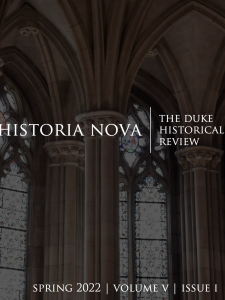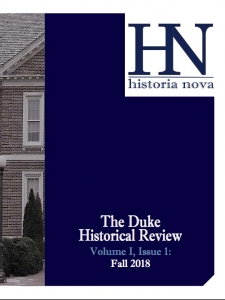Historia Nova features exceptional historical analysis from undergraduate students at Duke University and at institutions from across the United States and around the world, with the ultimate mission of showing that history is innovative, history is new, and history is ours, as our name would suggest.
Historia Nova is an undertaking by undergraduate students at Duke University. Duke University is not responsible for its contents.
For inquiries, please email dukehistorianova@gmail.com.
Spring 2025
Winter 2024
In This Issue-Preface (James Chappel, PhD) -Letter from the Editors (Jacob Margolis) -Enslaved Women in Flight: Analyzing Female Slave Flight through Fugitive Slave Advertisements (Jiewei Li, Duke University) -The Soviet Memorialization of Babi Yar 1941-1976 (Sophie Sacilotto, University of Victoria) -Historical Perspectives on the Langley Landscape, 1824-1920 (Stefano Buckley, University of Victoria) -A comparison of how Richard Wright, Frantz Fanon and W.E.B. Du Bois challenged racial domination, in relation to their philosophical and psychological influences, 1945-1963 (Austin Steele, University of Cambridge) |
Spring 2023
In This Issue- Preface (James Chappel, Incoming Director of Undergraduate Studies) - Letter from the Editors (Patrick Duan) - A Culture of Cleansing: An Analysis of the Persistent Ubiquity of Limpieza Social in Colombia, Since 1990 (Benjamin Goodwin, University College London) - ‘The Moment of Truth’: Cold War Civil Rights in Birmingham, Alabama, 1963 (William Johnson, University of Southampton) - Black Intellectuality: Challenging Conventions of Belonging in STEM (Rebekah Kristal, Brandeis University) - Writing Against the Decentralization Thesis: Towards a New Approach to the Study of Power in the Ottoman Long Eighteenth Century (Julian Polanski, Simon Fraser University) - ‘Woe to the Coolie’: Conceptualising Relationality, Class Conflict, and Regimes of Control in Colonial Sumatra’s Plantation Belt (Kai Siallagan, Queen’s University) |
Spring 2022
In This Issue- Preface (John D. French, Interim Director of Undergraduate Studies) |
Fall 2021
In This Issue- Preface ( John D. French, Interim Director of Undergraduate Studies |
Spring 2021
|
| In This Issue- Letter from the Editor (Brenden Li) |
Spring 2019
In This Issue- Letter from the Editors (Sisi Tang and Karan Thadhani) |
Fall 2018
In This Issue- The Samurai and the Swastika: German Popular Culture Images of Japan during the Nazi Era (Alan Ko) |









